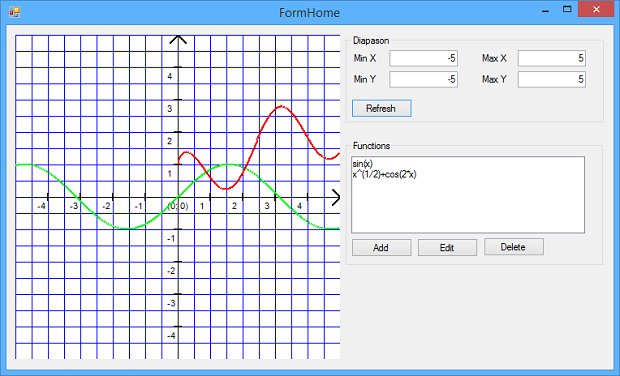非常好的一篇文章,Graph of Function
来源:互联网 发布:java 字符串分割 编辑:程序博客网 时间:2024/05/17 07:44
原文:http://www.codeproject.com/Articles/713686/Graph-of-Function
- Download GraphOfFunction-noexe.zip - 245.2 KB
- Download GraphOfFunction.zip - 404.5 KB
Introduction
My program allows you to build a graph of a function given a string. In the program the user himself defines the boundaries within which there is a graph of the construction and function of the color line. To change the priority operations can use parentheses. The program examines the construction schedule affiliation argument domain of the function. Therefore, the graph is constructed only in locations that are the domain of the function. You can build any number of graphics functions, setting for each color display. You can change and delete functions are introduced.
Windows
The main program window.

Window entry functions.

Architecture
The program works in the following way change a character string, a list of tokens, syntax tree. Character string is a collection of some symbols that represent operations, functions, numbers, parentheses, variables x and constants pi and e token . List of tokens is a list of instances of classes that implement the interface Isintahnode. Syntax tree is a tree whose nodes are operations, functions, numbers, constants and variables are in accordance with the priority of their implementation.

Graph drawing takes place on the panel using the methods of class Graphics.
Using the code
Interface ISyntaxNode describes the behavior of token. Method GetResult returns result for this token. Method IsDomainOfFunction checks whether the value of x belongs to the domain of definition of the token. Method ToStringValue returns the symbol for the token.
public interface ISyntaxNode{ string ToStringValue(); double GetResult(double x); bool IsDomainOfFunction(double x);} Class Function that inherits the interface ISyntaxNode.
abstract class Function: ISyntaxNode{ private ISyntaxNode x; public Function() { } public Function(ISyntaxNode x) { this.x = x; } public ISyntaxNode GetX() { return x; } public void SetX(ISyntaxNode x) { this.x = x; } public abstract double GetResult(double x); public abstract bool IsDomainOfFunction(double x); public abstract string ToStringValue();}Class Sin that inherits from the class Function and implements the abstract methods.
class Sin: Function{ public Sin(): base() { } public Sin(ISyntaxNode x): base (x) { } public override double GetResult(double x) { return Math.Sin(GetX().GetResult(x)); } public override bool IsDomainOfFunction(double x) { return GetX().IsDomainOfFunction(x); } public override string ToStringValue() { return "sin"; }}Attributes of the class SyntaxTree that performs build syntax tree.
listOperations - is a list conventional signs operations and functions that support the program.
listBynaryOperations - is a list conventional signs binary operations that support the program.
listUnaryOperations - is a list conventional signs unary operations that support the program.
listFunctions - is a list conventional signs functions that support the program.
root - is the root of syntax trees.
static List<string> listOperations = new List<string>(new string[] { "+", "-", "*", "/", "--", "^", "sin", "cos", "tan", "ctg", "log", "abs"});static List<string> listBinaryOperations = new List<string>(new string[] { "+", "-", "*", "/", "^"});static List<string> listUnaryOperations = new List<string>(new string[] {"--" });static List<string> listFunctions = new List<string>(new string[] { "sin", "cos", "tan", "ctg", "log", "abs" });private ISyntaxNode root; Method BuildSyntaxTree that performs build syntax tree. Method takes one parameter, which contains a list of tokens and return operations or functions with the lowest priority.
private ISyntaxNode BuildSyntaxTree(List<ISyntaxNode> listNode){ DeleteExcessiveBrackets(listNode); if (listNode.Count == 1) return listNode[0]; int position; ISyntaxNode min = FindMinPrioritiOperation(listNode, out position); if (listBinaryOperations.IndexOf(min.ToStringValue()) != -1) { BinaryOperation operation = min as BinaryOperation; operation.SetA(BuildSyntaxTree(listNode.GetRange(0, position))); operation.SetB(BuildSyntaxTree(listNode.GetRange(position + 1,listNode.Count - (position +1)))); } if (listUnaryOperations.IndexOf(min.ToStringValue()) != -1) { UnaryOperation operation = min as UnaryOperation; operation.SetA(BuildSyntaxTree(listNode.GetRange(position + 1, listNode.Count - (position + 1)))); } if (listFunctions.IndexOf(min.ToStringValue()) != -1) { Function function = min as Function; function.SetX(BuildSyntaxTree(listNode.GetRange(position + 1, listNode.Count - (position + 1)))); } return min;}Method DeleteExcessiveBrackets deletes excessive brackets. Sample: expression before executing the method - ((9-x)*17-2); expression after execution method - (9-x)*17-2.

Method FindMinPrioritiOperation seeking operation is the lowest priority. Sample: expression - (9-x)*17-2; result - operation - and position 7.

Drawing graphics
private void DrawFunction(string function, Color functionColor){ int sizeX = panelGraphFunction.Size.Width; int sizeY = panelGraphFunction.Size.Height; double minX = -10, maxX = 10; double minY = -10, maxY = 10; minX = Convert.ToDouble(textBoxMinX.Text); maxX = Convert.ToDouble(textBoxMaxX.Text); minY = Convert.ToDouble(textBoxMinY.Text); maxY = Convert.ToDouble(textBoxMaxY.Text); SyntaxTree calculator = new SyntaxTree(function); Graphics g = panelGraphFunction.CreateGraphics(); Point currentPoint = new Point(); Point previousPoint = new Point(); bool isCurentPoint = false; bool isPreviousPoint = false; for (double x = minX; x < maxX; x += (maxX - minX) / sizeX) { double y = calculator.Calculate(x, out isCurentPoint); if (Math.Abs(y) > maxY * 2) isCurentPoint = false; if (isCurentPoint) { currentPoint.X = (int)(x / ((maxX - minX) / sizeX) - minX / ((maxX - minX) / (double)sizeX)); currentPoint.Y = (int)(sizeY - (y / ((maxY - minY) / sizeY) - minY / ((maxY - minY) / (double)sizeY))); if (isPreviousPoint) { g.DrawLine(new Pen(functionColor, 2), previousPoint, currentPoint); } } previousPoint = currentPoint; isPreviousPoint = isCurentPoint; }}- 非常好的一篇文章,Graph of Function
- 一篇介绍netfilter的非常好的文章
- 一篇关于反射的非常好的文章
- 推荐一篇非常好的CakePHP入门文章
- 非常好的一篇文章,独自收藏了!
- 一篇介绍SNMP非常好的文章
- C++内存管理,非常好的一篇文章
- 一篇讲解android线程非常好的文章
- 一篇介绍javascript非常好的文章
- 非常好的一篇有关连接和加载的文章
- 一篇关于字节对齐的非常好的文章
- 转 :一篇关于字节对齐的非常好的文章
- 一篇介绍Nevow的非常好的文章,推荐
- 非常好的一篇U-BOOT的文章--转载
- 一篇非常好的字节序对齐的文章
- 非常好的一篇讲c++学习方法的文章
- 转载一篇总结的非常好的内存分析文章
- 非常好的一篇关于MYSQL编码问题的文章
- java自定义jar包读取Excel(包含2003和2007)数据,并举例说明
- js 正则表达式 验证字符串中必须包含字母和数字
- webview网页视图用css控制样式
- Linux C定时器使用
- Matlab precessing KTH by 00sequence.txt
- 非常好的一篇文章,Graph of Function
- 【Leetcode】Search a 2D Matrix
- SQL中索引的原理
- 判断互质数的方法
- 之前自己建的blog
- org/objectweb/asm/Type异常解决办法
- If a string is Palindromic
- Java获取本机IP列表的几种方法
- 常用的Javascript设计模式


